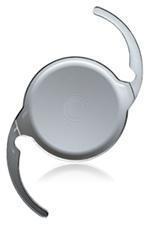
Tecnis multifocal lenses improve vision at multiple distances and in all lighting conditions. They are used to treat Phoenix, Scottsdale, Mesa and Tempe cataract and refractive patients with and without presbyopia. For many people, Tecnis multifocal lenses can eliminate the need to wear reading glasses. Studies have shown that nearly nine out of 10 Tecnis patients no longer need reading glasses after surgery, and can engage normally in their favorite activities, such as boating, quilting, playing golf and sightseeing. Tecnis lenses have a stellar satisfaction rate, with almost 92 percent of patients saying they would elect to do it again.
If you live in Phoenix, Scottsdale, Mesa or Tempe and want to find out if you are a candidate for Tecnis lenses, please contact Southwestern Eye Center today.
Important Safety Information – TECNIS® Multifocal Intraocular Lens (IOL)

Risks: As with many things, there may be a trade-off. If you decide to have a multifocal lens, your use of glasses may decrease, but at the cost of losing some of the sharpness of your vision. Even with glasses, this loss of sharpness may become worse under poor-visibility conditions such as dim lighting or fog. There may also be some visual side effects, such as halos and glare from lights at night, that are more common than with a monofocal IOL. Halos are rings of light that you may notice when looking directly at a source of light, such as oncoming car headlights. Glare is a scattered light effect that can appear around a source of light.
General risks with cataract surgery or refractive lens exchange surgery and IOL implantation: Whatever your lens choice, there are risks and possible complications of cataract surgery and lens implantation. Complications could be minor or temporary, or could permanently affect your vision. Complications are rare and may include worsening of your vision, bleeding or infection. Contact your eye doctor right away if you have any of the following symptoms after surgery: itching, pain, flashing lights,”floaters,” a “curtain” in your vision, redness, severe headache, nausea/vomiting, sensitivity to light or watery eye.
PLEASE NOTE: Warnings and precautions accompany all IOLs because they are prescription-only medical devices. The following warnings and precautions apply to all multifocal IOLs.
Warnings: A very small number of patients (less than 1% in US clinical studies) may be dissatisfied and request removal of their multifocal IOL. Under poor-visibility conditions, your vision may be reduced more than it would be with a monofocal IOL. Under these conditions, you may have more difficulty recognizing some traffic signs and hard-to-see objects on the road. Therefore, you may need to take extra care when driving, especially in poor-light conditions. In rare instances, multifocal IOLs may make some types of retinal surgery more difficult.
Precautions: If your eye is not healthy (including glaucoma), your vision may not be good even after your cataract is removed. In this case, you may not get the full benefit of the multifocal IOL. Before surgery, your eye doctor will check to see if you have any eye diseases. Be sure to tell your eye doctor if you have any health conditions that may affect your surgery or vision, and provide an updated list of medications to the doctor. There is a chance that your vision with a multifocal IOL may not be good enough to perform very near or detailed “up close” work without glasses. The TECNIS® Multifocal IOL is designed for near vision at approximately 13 inches. Take all prescribed medicines and apply eye drops as instructed. You should avoid any activity that could harm your eye while you are recovering from surgery. Before and after the surgery, your eye doctor will tell you about activity restrictions. If you wear contact lenses, your eye doctor may ask you to discontinue wearing your lenses prior to being evaluated for the multifocal IOL. There were no patients 21 years old or younger included in the clinical study. As a result, there are insufficient data to support safety and effectiveness of this IOL in this age group.
Adverse events: The most frequently reported adverse event that occurred during the clinical trial of the TECNIS® Multifocal lens was macular edema, which occurred at a rate of 2.6%. Other reported reactions, occurring in 0.3%-1.2% of patients, were inflammation of the eye and secondary surgical intervention (including biometry error, retinal repair, iris prolapse/wound repair, trabeculectomy, lens repositioning and patient dissatisfaction).
Cataract Self-Evaluation
See if you’re ready to take the next steps towards better vision.